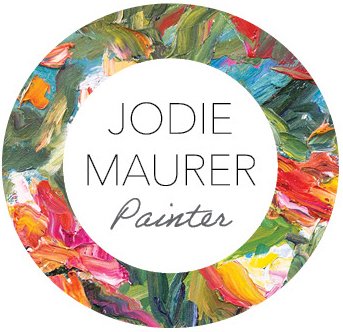The painting of Yosemite was done from a photograph sent to me by two hikers. I studied the forms of the landscape through a rough sketch and immediately was compelled to paint the view as though I had been there myself. Painting on location the past several years gave me practice with the skills needed to move past looking at a photograph to feeling the presence of the landscape.
Yosemite, Oil, 12x24in
Mentally, I was there taking in the view and exaggerating colors to match the emotions within me that result in the wonder and awe of standing in the presence of greatness. Each mountain and cliff defined by individual beauties as they towered over the plain below lifted the forest to the sky and pointed my view towards heaven.
The painting process for Yosemite started with finding the horizon and marking in key forms. It developed through layers of colors starting with loose strokes of oils thinned with mineral spirits to thick definitive marks. Cooler ultramarine blues were placed in distant forms and warmer cerulean blues in closer forms. Warm sienna colors were placed in the fields and marked the cliff faces and layers of warm and cool whites packed the distant peaks with snow.
I focused on capturing the feeling of being present with the land, rather than copying the photograph verbatim.
The below journal entry from six years ago resonated with me while I was reflecting on the process of painting Yosemite. I found similarities in how I studied the colors and forms of the landscape and the ever reappearing truth that each painting certainly does take on a life of its own. There is a point in painting a landscape when the conversation shifts from allegiance to the landscape to the painting.
Excerpt from my painting journal:
Painting Practice Class with Duncan Martin 2011.
Week 3, Monday, reflection after painting from 4-6pm
Yesterday I found the colors I want to use. Today I studied George Nick. His colors were realistic, but heightened and his forms clearly defined.
Today my goal was to be truthful by painting clear shapes with colors I saw at the field location.
Rockwell Kent painted snow beautifully with intense blue shadows, gray blue areas, and cool yellow lit snow. I started with a single wash of ultramarine blue, the under-painting (Nick always does blue).
I thought this under-painting would give the piece a cool feeling and help me simplify form by unifying the painting. I also felt it would help me stick with colors that relate to the landscape.
Today I was ready to think more about form. I used the photograph and saw something I hadn’t seen before: shapes of shadow in the snow. Not just the field’s shadow shape, but also ripples from the wind and terrain. Looking at Kent, Thomson, and Nick helped me notice colors and shapes, which I’ve been working out in each piece.
I have more control over the paint. I’m not mixing it and piling it all on the canvas. I am being more deliberate with the strokes and color temperature.
I need to see what the painting needs for a sky. It has taken on a life of its own, so I look to it for an answer.
The snow needs to be broken up in an intense area because it draws away from the rest of the painting. Right now it looks like a night sky with moonlight.

